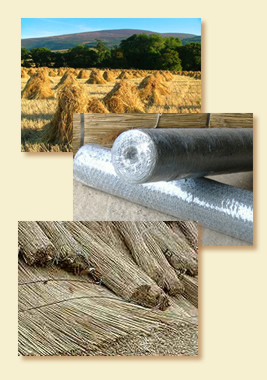About Thatching
Today the three most widely used materials for thatching are long straw, combed wheat reed and water reed.
Long straw and Combed wheat reed (also called Devon reed) are the same material but are processed in different ways. For long straw the harvested crop is fed into the drum of a threshing machine, which removes the grain from the ears while leaving the straw bruised, but largely intact. In contrast, combed wheat reed is fed into a comber attachment, which sits over the drum of the threshing machine, removes short straws, without crushing the stems and with all the stems lying in the same direction is tied into bundles ready for the thatcher.
Water reed (sometimes referred to as Norfolk reed) is a totally different product and unlike wheat reed was never an agricultural bi-product. Most native water reed is grown in managed reed beds in Norfolk however shortage of supply has resulted in most water reed today being imported from Eastern Europe.
When a house is re-thatched it is traditional for the old thatch to be stripped down to a firm base into which the new thatch can be fixed. In some circumstances water reed is fixed onto a base layer of wheat reed. In some cases, for instance if the roof has been so neglected that the roof structure itself needs to be repaired; it is necessary to strip the entire roof.
With all materials the thatch is laid in the same way – in courses, upwards from the eaves to the ridge, the fixings of each course covered by the course above.
The thatch is fixed in place with a variety of materials dependant on individual circumstances – for example: hazel spars; steel thatching crooks; stainless steel screws and wires; mild steel rods or tied on with tarred twine or sisal.
Whatever material is used for the coat work the roof is then finished with a ridge of straw or sometimes sedge. Ridges generally fall into two categories: a flush ridge or the more decorative block-cut ridge. The flush ridge, as the name suggests, lies flush with the level of the coat work. The block cut ridge is finished to a depth of approximately 4” and is cut, either straight or with decorative curves. Both will have hazel pattern work but often the flush ridge being a simpler and plainer finish.
A potential area for leaks is where a chimney meets with the thatch – to prevent this flashings of either cement or sometimes lead will be fitted.
Wiring is used to prevent birds from pulling out straw from a roof. It is usually fitted to the ridge only of a water reed thatch or the entire roof of combed wheat and long straw. Each vertical drop of wire should be laid side by side and not overlapped; the two sides should be joined by sewing the seams – ie twisting the two seams at intervals of about 6 – 8” apart. This leaves a neat finish with less visual impact and also facilitates easy removal of the wire in the unlikely event of fire.
The risk of a thatch fire is less than it was once thought to be but when a thatch does catch fire it can be quite spectacular!
For a new build the architect or planning authority will often specify the installation of a physical barrier beneath the layer of thatch, of which there are different products currently on the market. Of course for houses already thatched this is not an option unless the old thatch is being completely stripped off. There are liquid fire retardant products available that can be sprayed onto the thatch, however there is concern that chemicals may change the basic behaviour of the material and affect the roof’s performance.
Since most thatch fires start because of a problem with the chimney or fireplace it is critical to keep the chimney in good repair and swept regularly. It is important that the correct size of wood burner is fitted and that liners are fitted correctly. Also taking care what is burnt, it using dry seasoned wood.
Top
Thatch longevity
The lifespan of a roof is impossible to predict since it depends on so many variables. The quality of the materials, local climate, roof design and not least the skill of the thatcher will all have an impact on the life of a thatch. However it is generally accepted that a water reed roof can be expected to last longer than combed wheat or long straw roof. As a rough guide a ridge will probably need replacing every 10 to 15 years; a combed wheat or long straw roof 20 – 30 years and a water reed anything from 30 – 50 years, however there are examples of combed wheat lasting for 50 years! Maintenance and repair of any damage will of course help to achieve maximum life span.
If your house is listed you will need to notify your conservation officer of proposed work and you will need Listed Building Consent for any proposed alteration such as change of material (say from combed wheat to water reed) or for change of ridge style.


